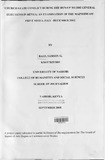| dc.description.abstract | This study sought to examine how the Kenyan print media covered the church-state conflict during the run-up to the 2002 elections. It focused on three leading daily newspapers; Daily Nation, Kenya Times and the East African Standard. The broad objective of the study was to determine the extent to which the Kenyan print media professionally covered the church-state conflict. However, there were a number of specific objectives which include: to examine the nature of the conflict as portrayed by the print media, to determine peoples' perception in regard to the coverage of the conflict and finally, on the basis of findings thereof, make appropriate recommendations on how the print media in Kenya can be made more professional.
The study made use of both primary and secondary sources of data. The primary source of data was interviews with fifty five members of the church congregation and fifteen media personnel to elicit their opinions. The secondary source of data included a content analysis of five hundred and fifty two copies of the dailies and the study and other available literature. Recent literature on media reporting and audience studies was reviewed to establish the relevance of the examination of the conflict as portrayed by the print media. Relevant communication and audience theories were also reviewed.
The major findings were that majority of the respondents perceived the coverage as inadequate and biased. The view of inadequate coverage is supported by findings of the content analysis that indicated a mere one hundred and forty five church-state conflict stories were covered within a six month period. Inadequate media reporting could be termed as self censorship and a form of bias.
One of the major conclusions of this study is that the print media failed to accord proportionate share of conflict coverage and where it occurred it was found to be largely biased. This is a failure on the part of the media to play its watchdog role of not only informing but also creating the much desired social, economic and political awareness as necessary ingredients for national development. The study recommends that there is need for continuous training of journalists and practice of modem management techniques in media houses in order to uplift the professional standing of the industry. | en |

